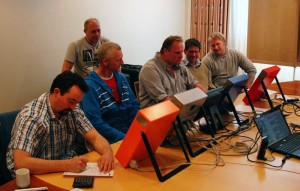Norske Shell enhances competency, preparedness post-Macondo on deepwater drilling campaign
 Using well control as a focus and simplifying procedures for the driller, Norske Shell established a new benchmark in real-time training best practices last year, Welltrain director Steven Collard said at the IADC Well Control of the Americas Conference & Exhibition in San Antonio, Texas, 25-26 August. He was referring to Norske Shell’s approach to continue a deepwater drilling campaign that was under way a continent away during the Macondo incident in 2010.
Using well control as a focus and simplifying procedures for the driller, Norske Shell established a new benchmark in real-time training best practices last year, Welltrain director Steven Collard said at the IADC Well Control of the Americas Conference & Exhibition in San Antonio, Texas, 25-26 August. He was referring to Norske Shell’s approach to continue a deepwater drilling campaign that was under way a continent away during the Macondo incident in 2010.
“We were still drilling the well when the Macondo incident investigations were being released,” Mr Collard said. “A lot of people were very nervous, particularly those not directly associated with the drilling operations. We even put together a well control course 101 to explain what well control is.”
That was only one action among many taken to achieve a level of trust, competence and preparedness during the two-well campaign. Operating in some of the deepest water that’s been explored offshore Norway at about 4,700 ft, two wells were drilled in a zero-discharge environment. The first well was conventionally drilled in less than 4,500 ft of water and drilled to 12,000 ft deep. “This was just a warm up for the next well, Dals Nuten,” Mr Collard noted.
Dals Nuten was a rank wildcat well planned for 17,000 ft in 4,700 ft of water. For the last 7,000 ft there were no pressure/temperature readings or seismic correlations. In addition, the best-case discovery was going to be between 1,500 and 1,800 ft of gas. “This was an upside for the geologist but not for the driller because of the hydrostatic column effect. To combat this problem, it was decided that rather than come in from the crest of the structure, the well would come in underneath a fault on the flank,” Mr Collard said.
Temperature and drilling fluids were a major problem in several sections. Very low mud weight and frac margins were expected in the 17 ½-in. hole, so low that hydrate inhibition was not possible. Conversely, in the 8 ½-in. section they were expecting temperatures to exceed 360°F on bottom. “It was much more than that in the end,” Mr Collard said.
The seabed temperature was less than 0°C, which required the use of a high-temperature, oil-based mud. A gas sand was also expected at the bottom of the 17 ½-in. hole section. The low mud weights were predicted to generate very high migration rates if a gas kick was taken; so high, in fact, that the simulation indicated that if no action was taken with a 40-bbl kick within 15 minutes, the shoe would break down. The solution to this problem was a crew that could respond very quickly.
The brand-new sixth-generation semisubmersible the Aker Barents, on long-term contract to Det Norske, represented another challenge. This Shell campaign was to be the semi’s first deepwater campaign. The semi had drilled only four wells when it started working for Shell, drilling in less than 1,000 ft of water. The BOPs had not been below 1,000 ft, and the well control equipment had not been used. The marine crew had few members with deepwater drilling experience.
The kill lines were dressed with 3 ½-in. pipe work that needed to be replaced with 4 ½-in. pipe before starting the well; the 3 ½-in. pipe was left on the BOP. Additionally, the contracting company was relatively new, and the crew had limited deepwater experience and was focused on the new surface equipment. Norske Shell needed them to be focused on the subsurface.
It was decided that the way to overcome these challenges was to develop an offshore team. “Without that team, it wasn’t going to be possible to deliver these wells,” Mr Collard said. “The team focus was to be well control.” Four hands-on courses were run onshore using simulators; it was noted that this training built trust among Shell, Aker and Det Norske team members.
After Macondo, impacts on the project were felt, according to Mr Collard, forcing a review of the well design and the need to look at well control in terms of equipment and people. Casing design was found to be resilient and not subject to change. However, it was decided to set the lock-down ring prior to drilling out the bottomhole section. A wireless pressure gauge was installed inside the last casing string to validate casing load.
The shear ram pressure was increased from 3,000 psi to 5,000 psi, and the acoustic system required on the secondary BOP in Norway was tested at depth. A full-function test of the ROV intervention functionality on the BOP was performed on surface and at depth.
“The most critical thing that was seen to be required post-Macondo was actually competency of the people, the assurance of competence and an ongoing focus on well control,” Mr Collard said. “Two persons were put onto the rig whose focus was only well control. Both had 25 years of experience with a background in operations and training. The focus wasn’t just on the drilling operation but on everyone involved in the operations.”




